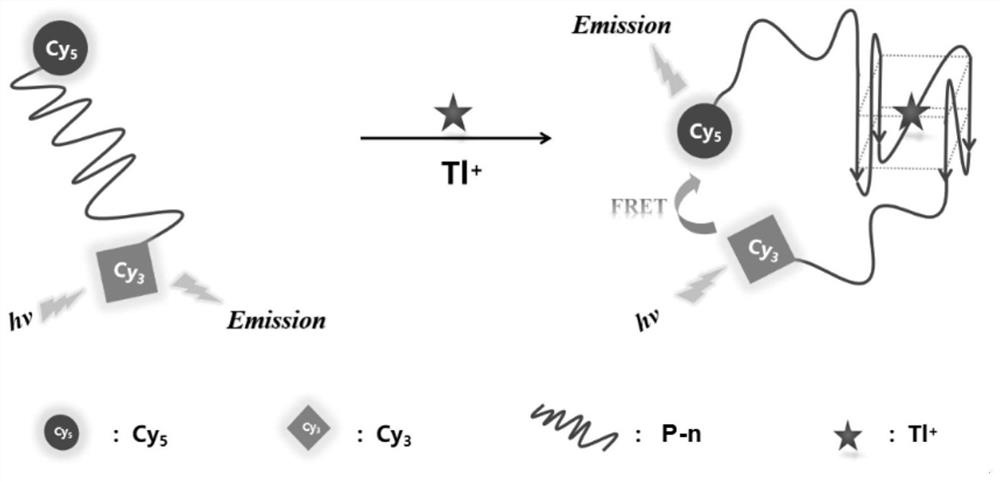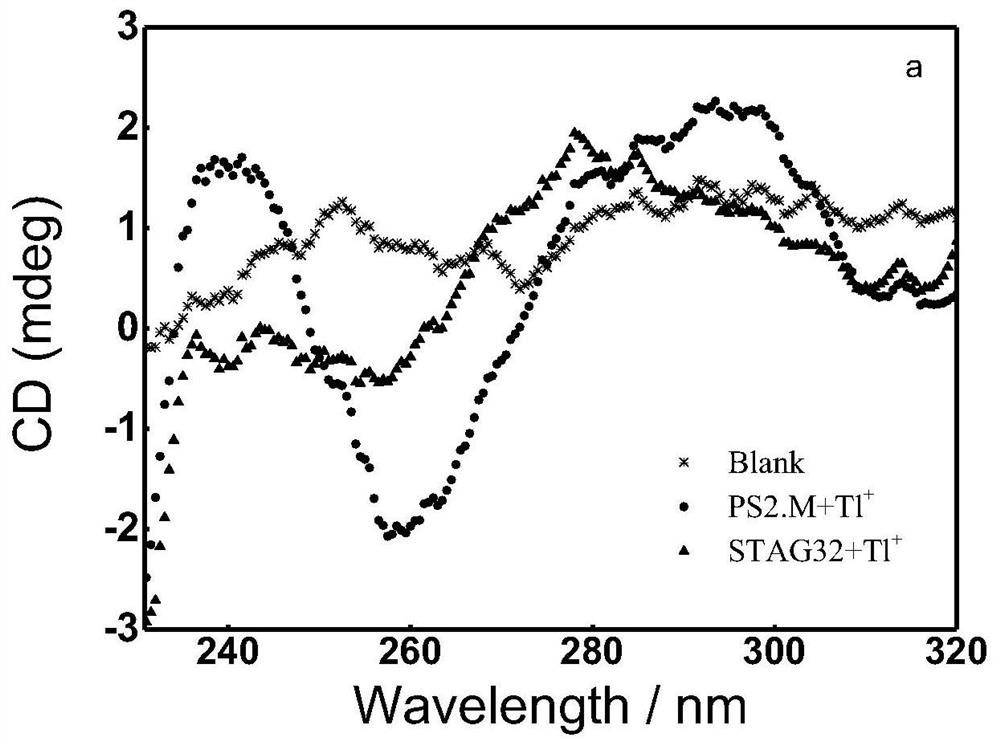Fluorescent probe for detecting Tl<+> based on nucleic acid aptamer
A technology of nucleic acid aptamers and fluorescent probes, applied in the field of fluorescent probes for detecting Tl+, can solve the problems of aptamer development and screening, difficulty in specific detection, difficulty in eliminating sensors, etc., and achieve background fluorescence Reduced, high fluorescence intensity and anti-interference ability, the effect of reduced fluorescence energy transfer efficiency
- Summary
- Abstract
- Description
- Claims
- Application Information
AI Technical Summary
Problems solved by technology
Method used
Image
Examples
Embodiment 1
[0046] Example 1: Screening the length of nucleic acid chain using fluorescence energy transfer efficiency
[0047] Objectives: By screening and optimization, low spontaneous fluorescence energy transfer nucleic acid chains are obtained to achieve lower detection background values.
[0048] In a 5 mM pH 7.6 Tris-HCl buffer solution, GACT-N mixed was mixed, allowing GACT-N in the buffer solution to 1 μm, and the stock solution was placed at a low temperature (4 ° C) stationary preservation.
[0049] Double-marked nucleic acid chain fluorescence detection. The excitation wavelength is set to 545 nm, and the base extension of Poly-T is selected based on the ratio of the detection signal (568 nm / 667 nm) to reduce the fluorescence energy transfer efficiency of both end fluorophores between the nucleic acid system when the target material is not added. Such as figure 2 As shown, i.e., when the STAG-N base group is ≥ 32, the spontaneous fluorescent energy transfer efficiency reaches a ...
Embodiment 2
[0051] Example 2: Comparison of detection ranges of different lengths GACT-N
[0052] Experimental purpose: based on TL + The detected linear range is compared to test the sensing performance of GACT24, GACT28, GACT32.
[0053] Compare the performance of GACT24, GACT28, and GACT32 to detect the performance of 铊 子. Formulated different concentrations TL + Standard solution, then different concentrations TL + The standard solution is mixed with GACT24, GACT28, GACT32 solution, incubated for 5 min at room temperature, and TL is carried out. + The specific binding reaction with the nucleic acid adapter, then fluorescence detection, the excitation wavelength is set to 545 nm, according to the ratio of the detection signal (568 nm / 667 nm), establish TL + The concentration is the standard curve of the conventional wave, the result is as Figure 4 Description, TL + When the concentration range is 0.2mm-1.0mm: GACT24, GACT28, GACT32 detection system is linear, corresponding R 2 From: 0.99...
Embodiment 3
[0055] Example 3: Establish TL + Standard curve of concentration and fluorescence ratio signal
[0056] Experimental purpose: establish TL + Standard curve of concentration and fluorescence ratio signal for quantitative detection TL + .
[0057] In a 5 mM pH 7.6 Tris-HCl buffer solution, the GACT32 mixed was mixed. The concentration of GACT32 was 1 μm in the buffer solution, which was placed at a low temperature (4 ° C) stationary, spare.
[0058] Establish TL + Standard curve of concentration and fluorescence ratio signal: TL of 0.01 ~ 10 mmol / L in the buffer system + The solution was added to each solution, 50 nm of GACT32 probe was added. Het the room temperature for 5 min, TL + The specifically binding reaction with the nucleic acid fitting, so that the fluorescent resonance energy between the fluorophores is transferred to produce a variation of the fluorescent signal, then perform fluorescence detection (fluorescence spectrum, such as Figure 5 As shown), the excitation wav...
PUM
| Property | Measurement | Unit |
|---|---|---|
| wavelength | aaaaa | aaaaa |
Abstract
Description
Claims
Application Information
 Login to View More
Login to View More - R&D
- Intellectual Property
- Life Sciences
- Materials
- Tech Scout
- Unparalleled Data Quality
- Higher Quality Content
- 60% Fewer Hallucinations
Browse by: Latest US Patents, China's latest patents, Technical Efficacy Thesaurus, Application Domain, Technology Topic, Popular Technical Reports.
© 2025 PatSnap. All rights reserved.Legal|Privacy policy|Modern Slavery Act Transparency Statement|Sitemap|About US| Contact US: help@patsnap.com



